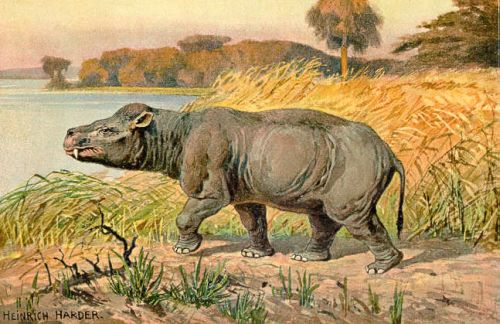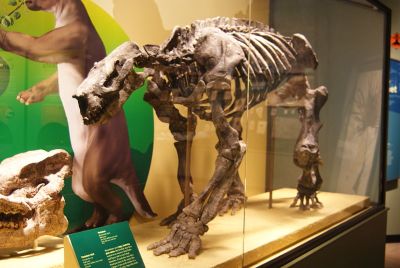
Coryphodon, a cow-sized pantodonta from the Early Eocene. this animal probably lived a semi-aquatic, hippo-like existence. Artwork by Heinrich Harder (public domain)
| Archaic Mammals | ||
| The Vertebrates | Pantodonta |
| Vertebrates Home | Vertebrate | Vertebrate |
|
Abbreviated Dendrogram
Eutheria
├?──┬─Palaeoryctidae
│ └?─┬─Pantolesta
│ └?─Ptolemaiidae
├?──┬─Pantodonta
│ └─Tillodontia
├?─Taeniodonta
├?─Dinocerata
╞?═Creodonts
├─Boreoeutheria
├─Afrotheria
└─Xenarthra
|
Contents
Overview |
Taxa on This Page
 Coryphodon, a cow-sized pantodonta from the Early Eocene. this animal probably lived a semi-aquatic, hippo-like existence. Artwork by Heinrich Harder (public domain) |
The Pantodonta were a group of graviportal, mostly herbivorous mammals that lived from the early Palaeocene to the mid-Eocene. Pantodonts varied in size from relatively small species of a few kilograms to over half a tonne in weight (from Lucas 1998). - CKT110403 The larger ones were the first mammals to attain large size, and the first synapsids, since the extinction of the dicynodonts in the late Triassic [1] to attain coverted megaherbivore status. MAK111210
The relationships of pantodonts to other mammals remains mysterious. At one time they were grouped with the dinocerata under the grouping of "amblypoda", they have also bene placed in the Cimolesta, or interpreted as distant relatives of the modern Carnivora, as an early branch of the Cetferungulata. It is also possible that they are they were actually an early side branch of the true placentals (apomorphic but not crown-group placentals). MAK120716
Note
[1] A fragment of purported dicynodont skull has been reported Mid Cretaceous of NE Australia (Thulborn & Turner 2003), and this has been compared with contemporary Australian Chigutisaurs as a Triasisc lazurus taxon. This comparison is misleading: brachyopoid temnospondyls are well known from the Jurassic of Australia and China, whereas Dicynodonts, which were large and easily fossilised animals, are totally unknown since the end of the Triassic. The possibility of the specimen being reworked from the Triassic should not be rejected. It is possible that it is also a case of mistaken identification. Quoting Agnolin et al 2010: "similarities with some baurusuchian crocodyliforms (e.g. Baurusuchus pachecoi; Riff & Kellner 2001) are striking. Among these traits are the presence of an anterolateral fossa, a large canine-tooth, and very small postcanine tooth. Thus, in light of the similarities between the Alderley dicynodont and baurusuchian crocodyliforms, a re-evaluation of the af?nities of this fragmentary specimen is warranted." (p.293) MAK120716

Pantodonta: Barylambda, Coryphodon, Pantolambda, Titanoides
Range: Paleocene to Eocene of North America and Asia,
Phylogeny: Placentalia/Crown Group Placentalia ::: Tillodontia + *)
Characters (from Lucas 1998): Head lacking cranial protuberances. P3 and P4 with V-shaped ectolophs; P2-P4 with broad metalophids; M1-M3 parastyles not projecting anterior to protocone-paracone line; M1-M3 metalophids and metaconids much taller than paracristids and paraconids. Legs with 'amblypod' carpus and tarsus.- CKT110403
Comments: diverse and important group of archaic herbivorees of unxcertain phylogenetic realtionships. May be closely related to Tillodonts. MAK1207160
Image: Mounted skeleton of Barylambda faberi, with part of a Coryphodon skull visible to the left. From the Evolving Planet Exhibit at the Field Museum, Chicago, IL. Photo by FunkMonk, Creative Commons Attribution, via Wikipedia
Page MAK120716, some content by Christopher Taylor